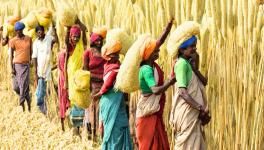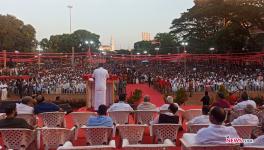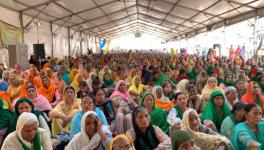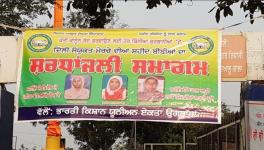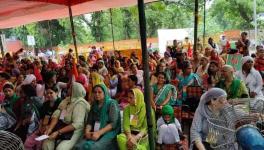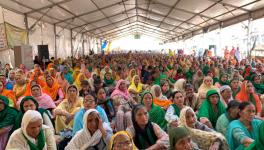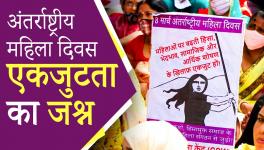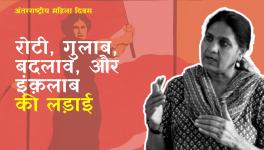Odisha: Women and Machine: How Gender-Friendly Equipment Bring Ease to Farmwork
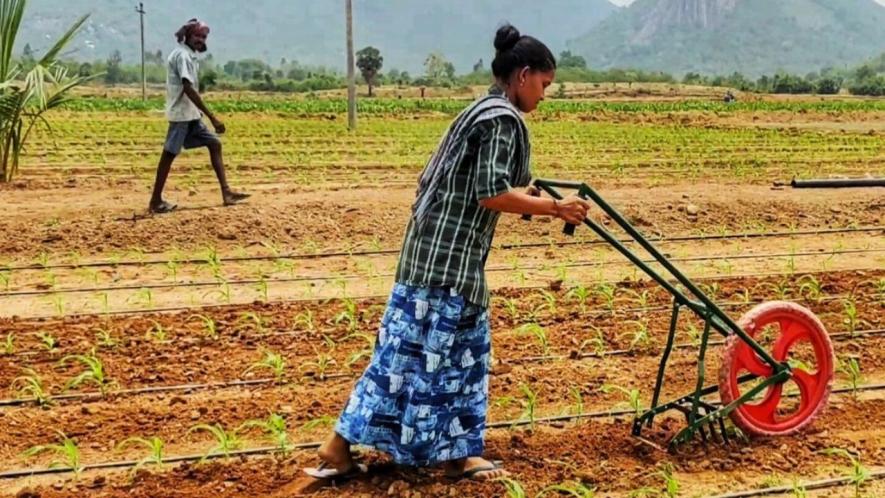
A woman farmer using cycle weeder in her farm in Parvathipuram under Manyam district of Andhra Pradesh (Photo - Abhijit Mohanty, 101Reporters).
Koraput, Odisha: Bati Bhumia (46) and her colleagues at Shree Maa Women’s Self-help Group (SHG) in Boipariguda block of Koraput now get some free time for themselves, thanks to the gender-friendly farm machinery and equipment introduced with an aim to reduce the drudgery of millet growing women farmers.
Traditionally, women process millets and it is a labour-intensive job where they spend hours separating the grain from straws, removing the outer cover of the grain, cleaning, grading, polishing and pounding it into flour. The cultivation of millets also involves much work.
“Every day, we used to spend five to six hours removing weeds from the farm. That has come down to three hours now as we use cycle weeders,’’ said Bhumia. What has made life easier for Bhumia is a crucial modification to include horizontal handlebars to cycle weeder, thereby enhancing its ergonomics.
Under Odisha Millets Mission (OMM), ragi thresher-cum-pearler, cleaner-cum-grader and cycle weeder were provided to 10 women SHGs in Koraput. However, after operating them, SHG members and farmers reported several challenges.
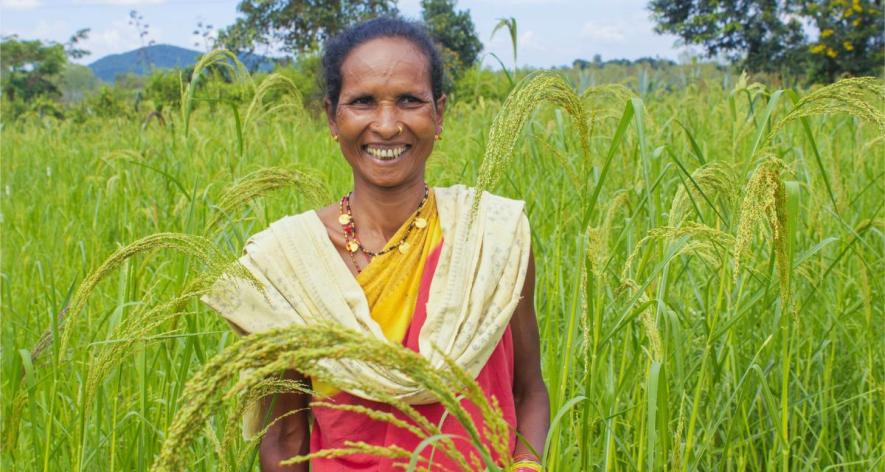
A tribal woman standing on her farm where she has grown little millet in Kundra block under Koraput district in Odisha (Photo - Abhijit Mohanty, 101Reporters).
“Cleaning ragi thresher-cum-pearler used to be a hassle because the sieves were not removable,” said Malati Jani (42), a member of Maa Tarini women’s SHG in Koraput block.
“Moving the thresher was also tough. The machine is very heavy. It required more hands to move it from one place to another,” added Parima Badnayak (23), another member.
When such challenges came to the fore, the Department of Agriculture and Farmers’ Empowerment (DA&FE) formed a Gender Analysis Committee (GAC) by involving gender specialists in 2022. It observed that machinery used in agriculture catered only to male biological aspects. It consulted SHG members and women farmers to comprehensively document their operational challenges as well as suggested modifications to the machine. Based on this, the manufacturers made modifications to make the machines women friendly.
Participatory machinery development (PMD) under OMM was one of the suggestions given by the GAC. The DA&FE has been promoting it under OMM since last year in Gajapati, Nuapada, Kendujhar, Koraput and Sundargarh districts, where it has reached out to 75 farmers in 15 villages in its first phase to create farm equipment that address their specific needs, preferences and challenges, with a special focus on women. In the subsequent phases, more farmers will be reached and the PMD initiative will be scaled up to all operational districts under OMM.
Therefore, when horizontal handlebars were introduced in cycle weeder, it allowed for a more natural and comfortable grip that facilitated pushing and pulling and reduced physical strain during prolonged deweeding operations. The cycle weeder is operated in a standing posture, whereas women stay bent for hours to uproot weeds in the traditional approach. Besides the transition from one to three tyne configuration, the blades have enabled more effective soil penetration, ensuring thorough coverage and effective weed control.
Similarly, the thresher has got wheels. “We can easily load it in a vehicle now and transport it to the farm and remote villages,” beamed Badnayak.
Jani too said that things have improved. “The sieves are removable now. We can easily clean the machine in less time,” she said.
Feminisation of agriculture
India is the largest producer and second-largest exporter of millets in the world. According to the Economic Survey of India, 2023, India alone produced 80% of the millets in Asia and accounted for 20% of its global production. According to the Annual Periodic Labour Force Survey, 2021-22, agriculture has the highest estimated female labour force participation of 62.9%.
“Rural men generally find it easy to operate most of the farm machines after receiving orientation and training,’’ said Usha Dharamraj, Principal Scientist, Central Food Technological Research Institute, Mysuru. She added that women farmers faced numerous challenges in operating farm machines as they are heavy and women unfriendly, often resulting in health hazards.
“Increasing feminisation of agricultural operations and ageing farmers are two fundamental social transformations taking place in rural heartlands. While developing plans for increasing productivity through mechanisation, the government should acknowledge and integrate this major social transformation,” Arabinda Kumar Padhee, Principal Secretary, DA&FE, told 101Reporters.
According to him, a pragmatic way of doing this is to promote customising suitability of technologies and tools through participatory approaches. “We will be gender and age testing every machinery that is used in the field, especially in millets and other crop operations.’’
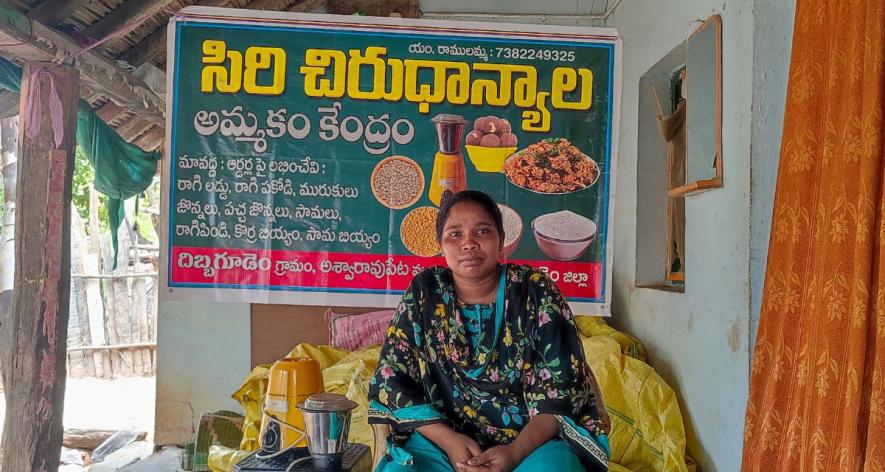
Mini millet mixer used by local SHGs in Telangana (Photo - Abhijit Mohanty, 101Reporters).
A recent study conducted by Mahila Kisan Adhikaar Manch (MAKAAM) in neighbouring Telangana revealed that majority of women farmers suffered from body aches, pains and musculoskeletal disorders due to intensive manual farm labour. “There is a need to explore new ways of design and development of machinery through participatory approach. Involving women farmers and elderly people, and incorporating their suggestions are the key,’’ said Dr V Rukmini Rao, a member of the national facilitation team of MAKAAM.
Private participation
The private sector can play a major role in delivering affordable and accessible farm solutions for women farmers. For instance, Farm Easy, a Hyderabad-based social enterprise founded by Watershed Support Services and Activities Network (WASSAN) is promoting innovative technology in farm implements to reduce manual workload of small and marginal farmers, especially women.
“We aim to ensure accessibility and availability of farm machines without compromising scientific rigour at a reasonable price,” said Farm Easy director Gembali Goutham. They are easy to operate and suitable for both men and women. They are also environment friendly as we ensure integration of decentralised renewable energy (solar energy), he added.
Farm Easy’s mini millet mixer efficiently removes husk from foxtail and little millets and processes them, including destoning and sieving. It is suitable for small-scale millet processing at household level. According to Goutham, several successful pilots to dehusk minor millets have been carried out. Azim Premji Foundation supported the research and development of the mixer.
Arika Ismeri (33) at Achapuvalasa village in Andhra Pradesh’s Manyam district is very happy with the mixer. “Earlier, we dehulled millets by pounding them in a wooden mortar. It is an extremely tedious process. It usually took half a day to prepare 2 kg of grain. But now, with the help of this mixer, we could process 4 kg of little millet in an hour.”
Similarly, combo sprayer designed ergonomically by Farm Easy reduces fatigue and back strain associated with the work. “As it is solar-powered, we can use it even when there is no power supply,’’ said Pallala Saraswati, a woman farmer at Thuruvada in Alluri Sitharamaraju district of Andhra Pradesh.
Farm Easy has designed and improved several other farm equipment as well. “These include a motorised baby pulper for coffee, a comprehensive and automated solution of preparing bio-inputs through fermenter-controller, and solar energy mobile carts that enable access to irrigation in uneven terrains,” said Gijivisha Khattry, senior programme officer, WASSAN, Hyderabad.
Policy concerns
“Amidst the changing climate, men in large numbers are migrating to cities in search of jobs,’’ said Sabarmatee, a Padma Shri recipient and founding member of Sambhav, an NGO working in Odisha’s Nayagarh district on gender justice and regenerative agriculture. “Left behind, women in villages bear the burden of agriculture alone. They spend a lot of time in their farms, but very little effort has been made to design equipment based on women's ergonomics and gender perception,’’ she added.
Sabarmatee said various factors, including the size of land holding, availability of replacement parts locally and power efficiency, should be kept in mind while agritech companies design farm machines, which are crop, operation and region specific.
According to the Food and Agriculture Organization estimates, if women had the same access to productive resources as men, they could increase yields on their farms by 20 to 30%, potentially resulting in a fall in hungry people globally by 100 to 150 million.
Peter Bakos has worked extensively with smallholders in India to develop appropriate technologies and multipurpose implements for agriculture and post-harvest mechanisation. “There should be a balance between men and women in agriculture to make it sustainable. The first step should be to involve men and initiate discussions on redefining masculinity and sharing agricultural responsibilities,” he said.
Abhijit Mohanty is an Odisha-based freelance journalist and a member of 101Reporters, a pan-India network of grassroots reporters.
Get the latest reports & analysis with people's perspective on Protests, movements & deep analytical videos, discussions of the current affairs in your Telegram app. Subscribe to NewsClick's Telegram channel & get Real-Time updates on stories, as they get published on our website.









